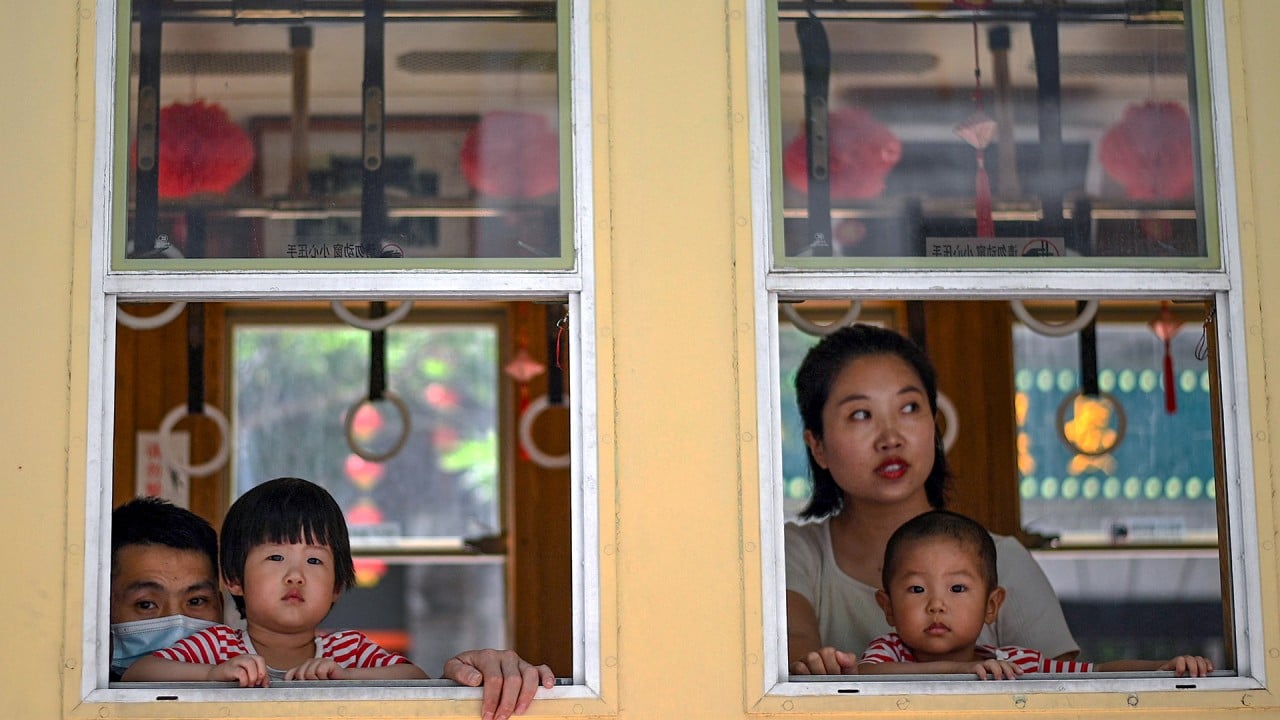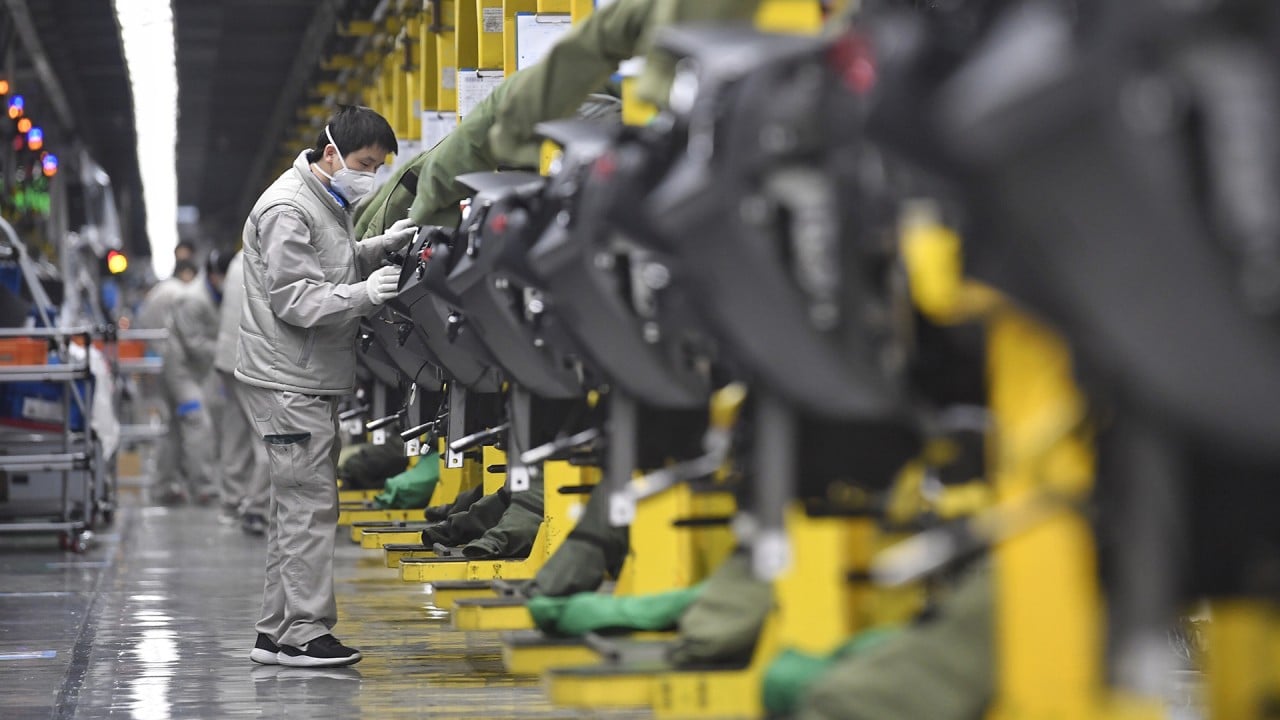
When will China overtake the US to become the world’s biggest economy?
- Forecasts from Bloomberg Economics suggest China could grab the top spot – held by the United States for well over a century – as soon as 2031
- In Beijing, following the 100th anniversary of the Chinese Communist Party, leaders are doing their best to present the baton-change as imminent and inevitable
When will China overtake the United States to become the world’s biggest economy? Few questions are more consequential, whether it is for executives wondering where long-term profits will come from, investors weighing the US dollar’s status as global reserve currency, or generals strategising over geopolitical flashpoints.
In Beijing, where they have just been celebrating the 100th anniversary of the Chinese Communist Party, leaders are doing their best to present the baton-change as imminent and inevitable.
“The Chinese nation,” President Xi Jinping said last week, “is marching towards a great rejuvenation at an unstoppable pace.”
Early in the coronavirus crisis, when China managed to control infections and maintain growth even as the US suffered hundreds of thousands of deaths and a crunching recession, many were inclined to agree. More recently, an unexpectedly fast US recovery has illustrated just how much uncertainty remains around the timing of the transition – and even whether it will happen at all.
The reason I haven’t bought three Rolls Royces is not because the government wouldn’t let me
But that outcome is far from guaranteed. China’s reform agenda is already languishing, tariffs and other trade curbs are disrupting access to global markets and advanced technologies, and coronavirus stimulus has lifted debt to record levels.
The nightmare scenario for Xi is that China could follow the same trajectory as Japan, also touted as a potential challenger to the US before it crashed three decades ago. A combination of reform failure, international isolation and financial crisis could halt China before it reaches the top.
Over the long haul, three factors determine an economy’s growth rate. The first is the size of the workforce. The second is the capital stock – everything from factories to transport infrastructure to communication networks. Finally there is productivity, or how effectively those first two can be combined.
In each of these areas, China faces an uncertain future.
Census confirms increase to 1.412 billion in 2020, but births fall again
Even if reforms succeed, it will be hard for China to offset the impact of the demographic drag. And they might not succeed. Rules are not the only thing holding families back from having more children: there is also the high cost of things like housing and education.
“The reason I haven’t bought three Rolls Royces is not because the government wouldn’t let me,” wrote one netizen in response to the three-child news.

03:49
How much does it cost to raise a child in China?
Overcapacity in industry, ghost towns of empty buildings, and six-lane highways snaking into sparsely populated farmland all illustrate the problem.
With the labour force set to shrink, and capital spending already overdone, it is productivity that holds the key to China’s future growth.
Boosting it, most Western economists think, requires action such as abolishing the creaking hukou system that ties workers to their place of birth, levelling the playing field between state-owned giants and nimble entrepreneurs, and reducing barriers to foreign participation in the economy and financial system.
Beijing’s industrial planners have their own blueprint – and China has a long track record of successful growth-enhancing reforms. With China only about 50 per cent as efficient as the US in how it combines labour and capital, there is still lots of room to improve.
By 2050, Bloomberg Economics projects China’s productivity will have caught up to 70 per cent of the US level – putting it in the typical range for countries at a comparable level of development.
Will China be able to deliver on the promise – boosting growth not with more workers and never-ending investment, but with smarter workers and more advanced technology?
Unfortunately for Beijing – and in contrast to the elaborately choreographed celebrations for the 100th anniversary of the Communist Party – not all the determinants of future growth are under their control.
If ties with the US and its allies continue to fray, the cross-border flow of ideas and innovations that has done so much to accelerate China’s rise will start to dry up. Beijing is already getting a sneak peak at what that might look like. Europe is backing away from a major investment agreement, and India closing the door to Chinese technology.
An elaborate exercise by economists at the International Monetary Fund found that in an extreme scenario, with China and the US dividing the world into separate spheres of influence, China’s 2030 GDP could take an 8 per cent hit – relative to a base case where ties stay stable.
Economic growth target of ‘above 6 per cent’ for 2021 confirmed
A combination of stalling domestic reforms and international isolation could bring another extreme scenario into play: financial crisis.
Since 2008, China’s credit-to-GDP ratio has rocketed from 140 per cent to 290 per cent – with the Covid stimulus contributing the latest leg up. In other countries, such a rapid increase in borrowing has heralded trouble ahead.
Drawing on Carmen Reinhart and Kenneth Rogoff’s study of financial crises, Bloomberg Economics estimates that a Lehman-style meltdown could push China into a deep recession followed by a lost decade of close to zero growth.

01:33
China’s economy accelerated at end of 2020, but virus-hit annual growth lowest in 45 years
There are also widespread doubts about the reliability of China’s official growth numbers. The country’s own leaders have acknowledged the problem. GDP data is “man-made,” current Premier Li Keqiang said when he was the head of Liaoning province. For a more reliable read, he preferred to look at the numbers for things like electricity output, rail freight and bank loans.
A study by economists at the Chinese University of Hong Kong and University of Chicago suggested that between 2010 and 2016, China’s “true” GDP growth was about 1.8 percentage points below what the official data suggested. If China is in fact already on a slower growth path, overtaking the US becomes harder.
“That’s not going to happen on my watch,” Biden said when he was asked about China’s ambition to take the global top spot. “Because the United States is going to continue to grow.”
Is China concerned about its population?
For the US, as for China, the path to faster growth lies through expanding the workforce, upgrading the capital stock and innovating on technology. Biden’s infrastructure and family plans represent trillion-dollar down-payments on doing just that. By lifting US growth onto a faster track, they could delay China’s ascendancy.
Drawing all these strands together, Bloomberg Economics has constructed scenarios for the outcome of the US – China economic race.
If everything goes right for China – from domestic reforms to international relations – then it could start the next decade neck-and-neck with the US – and then accelerate into the distance.
It is in Xi’s interest for the world to see that as the inevitable path. If political leaders, business executives and investment managers are convinced China is poised for pre-eminence, they have a strong incentive to get on the bandwagon – turning Beijing’s prophecy of success into a self-fulfilling one.
And Xi has the logic of development on his side. China’s 1.4 billion population is four times larger than that of the US; GDP per capita is currently less than 20 per cent of the level in the US It would only have to converge a little more for China to claim the top spot.
China’s past development success, as well as that of Asian neighbours Japan and South Korea, suggest that should not be too tall an order.
But as the chequered history of China’s last hundred years shows, development is not predestined. At the 100-year anniversary the focus – understandably – is on the successes of the last forty years. In earlier decades, the Communist Party’s record on delivering growth was – to say the least – much less impressive.
As Xi casts off the constraint of term limits and prepares for a third term as president, some fear a return of the leadership dysfunctions that blighted the earlier period of Communist rule.
If doubts start to creep in, another path is possible. Stalled reforms, fraying global ties, shrinking workforce and financial crisis could keep China indefinitely in second place.

